
The China rockfish, the yellowstripe rockfish or yellowspotted rockfish, is a species of marine ray-finned fish belonging to the subfamily Sebastinae, the rockfishes, part of the family Scorpaenidae. It is native to the waters of the Pacific Ocean off western North America.

The porae, the grey morwong, blue morwong, butterfish, Douglas' morwong, Eastern blue morwong, great perch, queen snapper, rubberlip morwong or silver morwong, is a species of marine ray-finned fish, traditionally regarded as belonging to the family Cheilodactylidae, the members of which are commonly known as morwongs. found around south eastern Australia and the north eastern coast of the North Island of New Zealand at depths of about 10 to 100 metres, on sandy and rocky coasts.

The blotched foxface, also called the blackblotch foxface or one-spot foxface, is a species of marine ray-finned fish, a rabbitfish belonging to the family Siganidae. It is found at reefs and lagoons in the central Indo-Pacific. Except for the black spot on the rear upper body, it resembles the closely related foxface rabbitfish.

The shortspine thornyhead, also known as the channel rockcod, shortspine channel rockfish or spinycheek rockfish, is a species of marine ray-finned fish belonging to the subfamily Sebastinae, the rockfishes, part of the family Scorpaenidae. It is sometimes referred to as the "idiot fish" or "idiot cod" due to its large oversize head/eyes. It is found in the northern and northeastern Pacific Ocean.

Sebastolobus, the thornyheads, is a genus of marine ray-finned fish belonging to the subfamily Sebastinae, the rockfishes, part of the family Scorpaenidae. These fishes are native to the northern and eastern Pacific Ocean. They are generally found in deep waters.
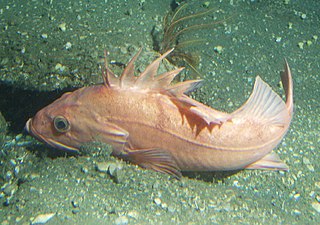
Sebastes levis, the cowcod or cow rockfish, is a species of marine ray-finned fish belonging to the subfamily Sebastinae, the rockfishes, part of the family Scorpaenidae. It is found in the eastern Pacific Ocean.

Sebastes miniatus, the vermilion rockfish, vermilion seaperch, red snapper, red rock cod, and rasher, is a species of marine ray-finned fish belonging to the subfamily Sebastinae, the rockfishes, part of the family Scorpaenidae. It is native to the waters of the Pacific Ocean off western North America from Baja California to Alaska.

Sebastes flavidus, the yellowtail rockfish or yellowtail seaperch is a species of marine ray-finned fish belonging to the subfamily Sebastinae, the rockfishes, part of the family Scorpaenidae. This species lives mainly off the coast of western North America from California to Alaska.

The quillback rockfish, also known as the quillback seaperch, is a species of marine ray-finned fish belonging to the subfamily Sebastinae, the rockfishes, part of the family Scorpaenidae. This species primarily dwells in salt water reefs. The average adult weighs 2–7 pounds and may reach 1 m in length. Quillback rockfish are named for the sharp, venomous quills or spines on the dorsal fin. Their mottled orange-brown coloring allows them to blend in with rocky bottom reefs. The quillback rockfish eats mainly crustaceans, but will also eat herring. They are solitary and minimally migratory, but not territorial, and give birth to live young (viviparous). They are a popular sport fish, generally caught in cold water 41–60 m deep, but also to subtidal depths of 275 m.
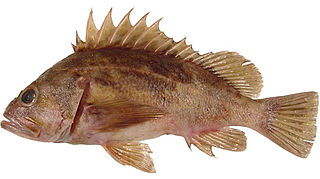
The brown rockfish, whose other names include brown seaperch, chocolate bass, brown bass and brown bomber, is a species of marine ray-finned fish belonging to the subfamily Sebastinae, the rockfishes, part of the family Scorpaenidae. It is found in the northeastern Pacific Ocean.

Chaenodraco wilsoni, the spiny icefish, is a species of marine ray-finned fish belonging to the family Channichthyidae, the crocodile icefishes. It is native to the Southern Ocean. This species is the only known member of its genus. It is of minor interest to commercial fisheries.

The painted sweetlips, also known as the Australian slatey, blackall, bluey, grey sweetlips, moke, morwong, mother-in-law fish, painted blubber-lips, slate bream, slate sweetlips, smokey bream, thicklip or yellowdot sweetlips is a species of marine ray-finned fish, a sweetlips belonging to the family Haemulidae. It is widespread throughout the tropical waters of the Indo-West Pacific region.

Pomadasys kaakan, the javelin grunter or barred javelin is a species of marine ray-finned fish, a grunt belonging to the family Haemulidae. It is native to the Indian and Pacific Oceans, from Africa to Australia.

Sebastes aurora, the aurora rockfish, is a species of marine ray-finned fish belonging to the subfamily Sebastinae, the rockfishes, part of the family Scorpaenidae. It is found in the northeastern Pacific Ocean.
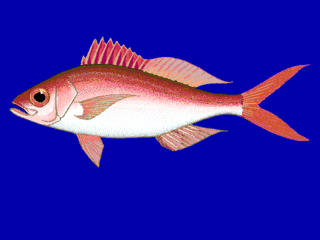
The queen snapper, also known as the night snapper or brim snapper, is a species of ray-finned fish, a snapper belonging to the family Lutjanidae. It is native to the western Atlantic Ocean, and is the only species in the genus Etelis found outside the Indo-Pacific region.
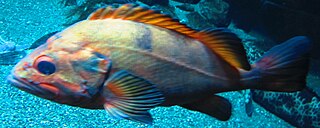
Sebastes melanostictus, the blackspotted rockfish, is a species of marine ray-finned fish belonging to the subfamily Sebastinae, the rockfishes, part of the family Scorpaenidae. It is found in the northern Pacific Ocean.
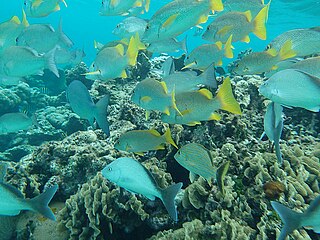
Haemulon album, the white margate, grey grunt, grunt, Margaret fish, Margaret grunt, margate, margate fish, ronco blanco, viuda, white grunt, white pogret, or yellow grunt is a species of ray-finned fish, a large grunt belonging to the family Haemulidae. It is native to the western Atlantic Ocean.

The rock cale, also known as the cockatoo fish, cocky, joey, rock cocky or sea carp, is a species of marine ray finned fish, one of the marblefishes belonging to the family Aplodactylidae. It is found in the southwestern Pacific Ocean.

Siganus spinus, the little spinefoot, scribbled rabbitfish, blunt-nosed spinefoot, spiny rabbitfish or spiny spinefoot, is a species of marine ray-finned fish, a rabbitfish belonging to the family Siganidae. It is found in the Indo-Pacific region.

Sebastolobus macrochir, the broadbanded thornyhead or broadfin thorny head, is a species of marine ray-finned fish belonging to the subfamily Sebastinae, the rockfishes, part of the family Scorpaenidae. It is found in deep waters of the northwestern Pacific Ocean.





















